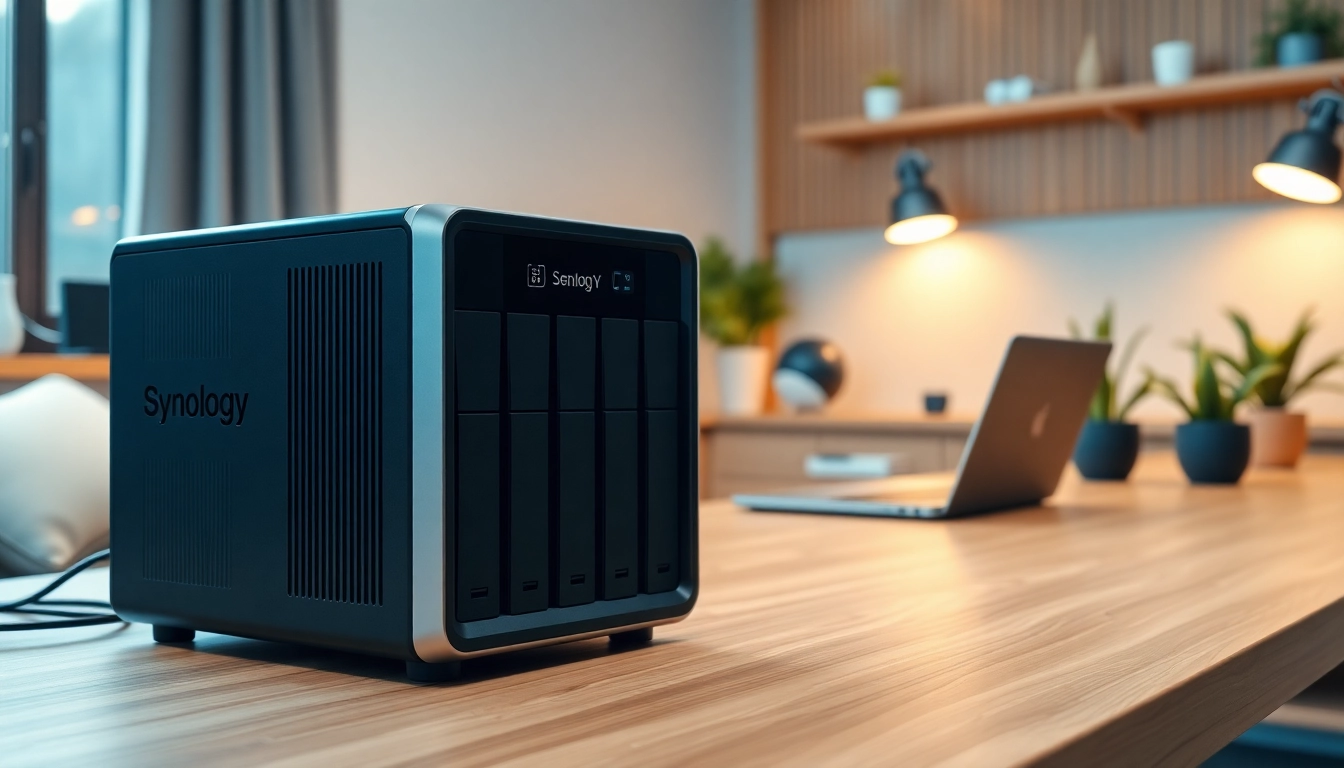Understanding Synology Storage: Features and Benefits
What is Synology Storage?
Synology Storage refers to the range of network-attached storage (NAS) devices and solutions developed by Synology, a leader in storage technology. These devices provide an efficient system for storing, managing, and retrieving data over a network, making them ideal for both home and business environments. The versatility of Synology Storage allows users to access their digital assets anytime and anywhere, provided that they connect to the internet. With a growing emphasis on cloud computing and online data management, Synology Storage provides a remarkable balance between local control and remote accessibility.
Key Features of Synology Storage
Synology Storage systems are mixed with an impressive array of features that enhance usability, performance, and security. Key features include:
- User-Friendly Interface: Synology’s DiskStation Manager (DSM) offers an intuitive and easy-to-navigate interface that simplifies management tasks, making it accessible even for users without extensive technical knowledge.
- Versatile File Sharing: Synology Storage allows users to share files seamlessly across various platforms, including Windows, macOS, Linux, and mobile devices, thus ensuring connectivity across diverse operating systems.
- Data Replication and Backup: Advanced backup options allow for data replication both locally and to the cloud, ensuring that critical information is secure and recoverable in case of failures.
- Security Features: Synology provides comprehensive security tools including firewalls, encryption, two-factor authentication, and regular security updates to safeguard user data.
- Scalability: With a wide range of models, Synology Storage devices can easily scale as your storage needs grow, whether for individual use or enterprise-level applications.
- Integration with Third-Party Applications: Synology’s platform supports various third-party applications that enhance its functionality, turning the storage device into a multi-purpose server.
Benefits of Using Synology Storage in Your Setup
Incorporating Synology Storage into your digital ecosystem provides numerous benefits:
- Centralized Data Management: All your data is stored in one place, making it easier to manage and access without needing multiple external hard drives or USB drives.
- Increased Accessibility: Accessible via remote connections, users can retrieve or share files from anywhere, enhancing collaboration and flexibility.
- Cost-Effective Data Management: Using Synology Storage can reduce costs associated with IT infrastructure, especially for businesses that require backup and redundancy solutions.
- Enhanced Collaboration: Team members can collaborate on projects in real-time with shared access to files, streamlining workflows and improving productivity.
Setting Up Your Synology Storage Device
Choosing the Right Model for Your Needs
When considering a Synology Storage device, it is essential to choose one that matches your intended use case. Synology offers various models tailored for different storage requirements, including:
- Entry-Level Devices: Ideal for home and small office setups, these models provide basic functions without overwhelming features.
- Mid-Range Devices: Suitable for growing businesses, these devices often support additional applications and more complex storage configurations.
- Enterprise Solutions: For larger organizations, Synology offers high-end models capable of handling extensive data loads, advanced redundancy setups, and enhanced security features.
Step-by-Step Setup Guide
Setting up your Synology Storage device is straightforward, typically involving the following steps:
- Unboxing and connecting the device to your network via Ethernet.
- Powering on your Synology Storage and locating its IP address using the Synology Assistant or your router settings.
- Accessing the web-based DiskStation Manager (DSM) interface through a browser with the assigned IP address.
- Following the setup wizard to create an administrator account, select your preferred language, and install any necessary updates.
- Configuring storage settings including RAID options to enhance redundancy and performance.
- Finalizing the setup and accessing shared folders and applications through the DSM interface.
Configuring Your Synology Storage for Optimal Performance
To maximize the effectiveness of your Synology Storage, consider the following configuration tips:
- Implement RAID Configurations: Depending on your data security needs, select the appropriate RAID setup—RAID 1, RAID 5, etc.—to ensure data redundancy and improved read/write speeds.
- Enable Storage Quotas: Manage your space utilization and prevent users from over-consuming storage, ensuring fair usage across all accounts.
- Regular Updates: Keep your DSM and applications updated to benefit from security patches and new features, maximizing system performance.
- Optimize Network Settings: Adjust settings such as Jumbo Frames if your environment supports it, resulting in enhanced network throughput.
Integrating Synology Storage with Other Technologies
Connecting Synology Storage to Your Network
Connecting your Synology Storage to your existing network is essential for ensuring file accessibility. Using solid Ethernet connections and potentially a dedicated switch for your NAS can improve performance, especially in environments with multiple users.
Using Synology Storage with Cloud Services
Enhancing your data management strategies, Synology Storage can be synchronized or backed up with various cloud services, allowing for additional redundancy or archival storage. Users can set up automatic backups to services like Amazon S3 or Dropbox, ensuring their data is always available even in the event of local hardware issues.
Enhancing Home Automation with Synology Storage
Synology Storage can interface with home automation systems, allowing users to manage their media libraries and surveillance systems directly from the NAS. This functionality centralizes control and access to essential tools, streamlining user experience in modern automated homes.
Optimizing Data Management with Synology Storage
Backup Solutions Using Synology Storage
Robust backup solutions formed through Synology Storage systems include:
- Snapshots: Implement snapshot technology for point-in-time backups, allowing for quick restoration in case of data loss.
- Remote and Local Backups: Utilize both local and remote ways to maintain backup copies, providing fail-safes against potential network failures.
- Versioning: Enable file versioning to maintain previous file states, allowing easy returns to earlier versions without overwriting current files.
Data Security Best Practices for Synology Storage
When it comes to securing your valuable data, consider the following best practices:
- Use Strong Passwords: Ensure that all accounts have complex and unique passwords to minimize unauthorized access risks.
- Enable 2FA: Two-factor authentication adds an extra layer of security; requiring a second verification step can greatly reduce unauthorized access.
- Regular Updates: Consistently update your DSM and installed applications to take advantage of the latest security enhancements.
- Firewall and Network Security: Configure your router settings, including firewalls and access control lists, to limit external access to your NAS.
Monitoring and Maintaining Your Synology Storage System
Ongoing monitoring of your Synology Storage systems is essential to ensure optimal performance:
- Use Synology’s Resource Monitor: Monitor CPU, memory, and network traffic to detect any unusual activities that may indicate issues.
- Check Drive Health: Regularly check drive health status using SMART data to predict potential failures and act timely.
- Logs and Alerts: Set up alerts for important events such as unauthorized access attempts or system errors to maintain constant vigilance.
Real-Life Applications of Synology Storage
Case Studies: Synology Storage in Small Businesses
Many small businesses have adopted Synology Storage solutions owing to their affordability and comprehensive feature sets. For instance, a small graphic design firm utilized Synology Storage to centralize its projects, enabling seamless collaboration among designers. The firm was able to significantly reduce project turnaround times due to improved file access speeds, achieving greater efficiency.
How Creatives Use Synology Storage for Large Projects
For creative professionals, large files often create limitations in storage and access. Synology Storage addresses these challenges effectively. Photographers and videographers use Synology as a central repository to store media assets, streamlining workflows and permitting easy access for clients to review projects at any time.
Future Trends: The Role of Synology Storage in Digital Workflows
As organizations continue to evolve digitally, the role of Synology Storage in workflows is set to expand. Innovations such as AI-based data management, increased integration with advanced cloud features, and improved user interfaces will redefine how users interact with their data, driving efficiency and supporting a new era of hybrid work solutions.



